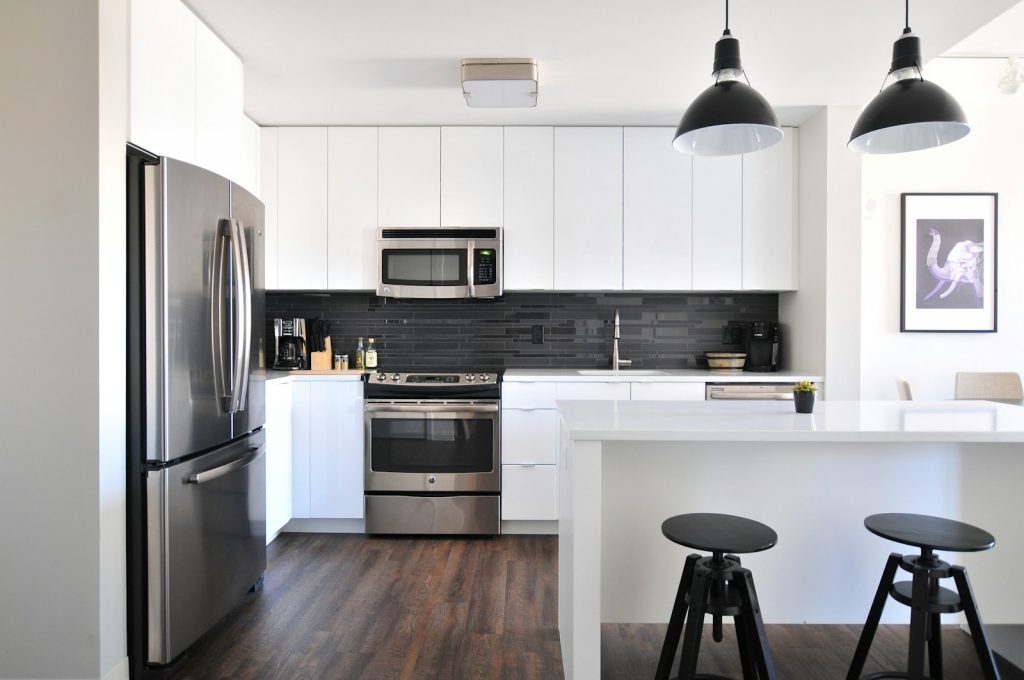出入動線的規劃:暢行無阻,安全至上
對於行動不便的巴金森氏症病人,出入動線的規劃必須以「無障礙」為首要目標,減少跌倒風險。中國醫藥大學附設醫院的文獻指出病人會因走路前傾或腿部突然僵硬而容易跌倒,強調為巴金森氏症病人創建安全和舒適的居家環境的非常重要。
入口和走道
確保入口平坦無障礙,移除門檻或改用斜坡。走道寬敞明亮,避免放置雜物或鋪設容易絆倒的地毯。安裝扶手能提供額外的支撐,特別是在樓梯和走道轉角處。考量加裝動作感應照明,方便夜間行走。
樓梯
如果家中樓梯是不可避免的,應加裝牢固的扶手,並考慮安裝樓梯升降椅,方便上下樓。
停車位
選擇靠近住家入口、寬敞且光線充足的停車位,最好是有遮雨棚設計,方便雨天進出。
衛浴空間的規劃:便利舒適,維護尊嚴
衛浴空間是意外發生率最高的地方之一。對於巴金森氏症病人來說,衛浴空間的規劃更需要注重安全和便利性。
浴室門
考量將浴室門改為向外開啟,方便在緊急情況下進入救援。
馬桶
安裝加高馬桶座,方便起身和坐下。馬桶旁加裝扶手,提供支撐。
淋浴區
移除浴缸,改為淋浴間,並加裝防滑墊和座椅。安裝可調式蓮蓬頭,方便不同高度的使用者。
洗手台
選擇高度適中的洗手台,並在下方預留空間,方便輪椅使用者靠近。
地面
使用防滑地磚,避免地面濕滑造成跌倒。
廚房的規劃:簡化流程,安全烹飪
廚房是另一個需要特別注意安全的地方。巴金森氏症病人可能因為手部顫抖或行動不便,增加烹飪的難度和危險性。
櫥櫃和抽屜
將常用的餐具和食材放在容易拿取的高度,避免過度彎腰或伸手。使用拉籃或旋轉架,方便拿取物品。
爐灶
選擇電磁爐或電陶爐,避免明火造成的燙傷風險。安裝定時器,避免忘記關火。
水槽
選擇單把手的水龍頭,方便操作。
餐具
使用防滑餐具,例如加重餐具、防滑碗盤等,方便抓握和使用。
臥室的規劃:舒適安穩,促進睡眠
臥室是休息和睡眠的地方,對於巴金森氏症病人來說,舒適的臥室環境有助於提升睡眠品質。
床鋪
選擇高度適中的床鋪,方便上下床。床邊加裝扶手,提供支撐。
燈光
安裝床頭燈,方便夜間使用。使用柔和的燈光,營造舒適的睡眠環境。
環境
保持臥室安靜、整潔,避免雜物堆積。
其他居家環境調整建議
照明
家中各處應保持充足的照明,減少陰暗角落。
地面
移除家中所有容易絆倒的物品,例如地毯、電線等。保持地面平整,避免高低差。
家具
選擇穩固的家具,避免使用容易傾倒的家具。家具之間保持足夠的空間,方便移動。
緊急呼叫系統
安裝緊急呼叫系統,方便在緊急情況下求救。
輔具
根據病人的個別需求,選用適當的輔具,例如助行器、輪椅等。
定期評估
隨著病情發展,病人的需求也會改變。建議定期評估居家環境,並根據需要進行調整。
與專業人士合作
規劃巴金森氏症病人的居家環境安全,最好能尋求專業人士的協助,例如職能治療師、物理治療師、建築師等。內政部的研究報告也提供了國外案例和建築環境設施需求,衛生福利部也與相關機構合作推廣居家照顧策略。他們能根據病人的個別需求,提供專業的建議和規劃。
持續溝通與支持
與病人及其家人保持良好的溝通,了解他們的需求和感受,並提供持續的支持和鼓勵。
額外資訊與資源
Abilities OTServices and Seminars
提供居家環境改造、輔具等相關資訊
Easter Seals
提供殘疾人士相關資源
AARP Home Modifications Guide
提供居家環境改造指南
Administration on Aging—Remodeling resources
提供居家環境改造資源
CASPAR Extended Home Living Services-home mods assessment tool
提供居家環境評估工具
Universal Home Design Guide
提供通用住宅設計指南
結語
為巴金森氏症病人打造一個安全舒適的居家環境,不僅能提升他們的生活品質,也能減輕照顧者的負擔。透過仔細的規劃和適當的調整,讓病人在家中也能享有安全、舒適和有尊嚴的生活。國民健康署的指引也強調了居家環境調整的重要性,指出每6名長者就有一人曾經跌倒,而且過半數的案例發生在住家內。
希望以上資訊能幫助您為巴金森氏症病人規劃一個更安全、舒適的居家環境。金曲歌后詹雅雯、女星方岑、抗議天王柯賜海、著名演員米高福克斯、藝人林松義以及作曲家李泰祥,他們的故事都提醒我們帕金森氏症可以發生在任何人身上,也展現了面對疾病的勇氣和毅力。
Reference
[1] Parkinson’s Disease and the Environment. /Frontiers in neurology /2019 LINK
[2] Analysis of Transition of Patients with Parkinson’s Disease into Institutional Care: A Retrospective Pilot Study. /Brain sciences /2021 LINK
[3] Planning for Prevention of Parkinson Disease: Now Is the Time. /Neurology /2022 LINK
[4] Challenges and Actions of IAQ under COVID19: A Survey of Taiwanese People’s Perception of Epidemic Prevention and Indoor Places Certification. /International journal of environmental research and public health /2022 LINK
[5] Proposal of a new conceptual gait model for patients with Parkinson’s disease based on factor analysis. /Biomedical engineering online /2019 LINK
[6] FourierBased Footfall Placement Variability in Parkinson’s Disease. /BioMed research international /2019 LINK
[7] Smart Wearable Device for Quantification of Risk of Fall: Exploring Role of Gait Phases and Knee Bending Angle for Parkinson’s Patients. /Annual International Conference of the IEEE Engineering in Medicine and Biology Society. IEEE Engineering in Medicine and Biology Society. Annual International Conference /2022 LINK
[8] Design of SmartWalk for Estimating Implication of Pathway with Turn and Task Condition on Postural and Gait Indices: Relevance to Fear of Fall. /IEEE transactions on neural systems and rehabilitation engineering : a publication of the IEEE Engineering in Medicine and Biology Society /2022 LINK
[9] Falls in Synucleinopathies. /The Canadian journal of neurological sciences. Le journal canadien des sciences neurologiques /2020 LINK
[10] Over Half of Falls Were Associated with Psychotropic Medication Use in Four Nursing Homes in Japan: A Retrospective Cohort Study. /International journal of environmental research and public health /2022 LINK
[11] Semiautomatic retractable handrail utilising opening/closing movement of sliding door supporting elderly people to walk independently: proposed and satisfied design specifications for elderly people. /Journal of medical engineering & technology /2022 LINK
[12] Development of a Clinical Prediction Rule for Adverse Events in Multimorbid Patients in Emergency and Hospitalisation. /International journal of environmental research and public health /2022 LINK
[13] Highlighting the goals for Parkinson’s care: commentary on NICE Guidelines for Parkinson’s in Adults (NG71). /Age and ageing /2019 LINK
[14] The Challenge of Managing Parkinson’s Disease Patients during the COVID19 Pandemic. /Annals of Indian Academy of Neurology /2020 LINK
[15] Using IMU Sensors to Assess Motor Degradation of PD Patients by Modeling Inmeal PlatetoMouth Movement Elongation. /Annual International Conference of the IEEE Engineering in Medicine and Biology Society. IEEE Engineering in Medicine and Biology Society. Annual International Conference /2020 LINK
[16] Planning for Prevention of Parkinson Disease: Now Is the Time. /Neurology /2022 LINK
[17] Potential predictors of quality of life in Parkinson’s Disease: Sleep and mood disorders. /Journal of clinical neuroscience : official journal of the Neurosurgical Society of Australasia /2019 LINK
[18] Factors Related to Sleep Disturbances for Informal Carers of Individuals With PD and Dyadic Relationship: A Rural Perspective. /Journal of geriatric psychiatry and neurology /2021 LINK
[19] Bidirectional Relationship Between Sleep Disturbances and Parkinson’s Disease. /Frontiers in neurology /2022 LINK
[20] Chronobiology of Parkinson’s disease: Past, present and future. /The European journal of neuroscience /2022 LINK
[21] Using an Electronic Tablet to Assess Patients’ Home Environment by Videoconferencing Prior to Hospital Discharge: Protocol for a MixedMethods Feasibility and Comparative Study. /JMIR research protocols /2019 LINK
[22] A guide for accommodating wheelchairs in the OR while maintaining safety and quality. /American journal of infection control /2021 LINK
[23] Machine Learning Algorithm Identifies the Importance of Environmental Factors for Hospital Discharge to Home of Stroke Patients using Wheelchair after Discharge. /Journal of stroke and cerebrovascular diseases : the official journal of National Stroke Association /2021 LINK
[24] Considerations of the built environment for autistic individuals: A review of the literature. /Autism : the international journal of research and practice /2022 LINK
[25] A systematic review of active groupbased dance, singing, music therapy and theatrical interventions for quality of life, functional communication, speech, motor function and cognitive status in people with Parkinson’s disease. /BMC neurology /2020 LINK
[26] HomeBased Care for People with Alzheimer’s Disease and Related Dementias (ADRD) during COVID19 Pandemic: From Challenges to Solutions. /International journal of environmental research and public health /2020 LINK
[27] The Influence of Walking Limitations on Daily Life: A MixedMethods Study of 14 Persons with Late Effects of Polio. /International journal of environmental research and public health /2022 LINK
[28] Levelling the Playing Field: The Role of Workshops to Explore How People With Parkinson’s Use Music for Mood and Movement Management as Part of a Patient and Public Involvement Strategy. /Frontiers in rehabilitation sciences /2022 LINK
[29] Expert Consensus on the Care and Management of Patients with Cognitive Impairment in China. /Neuroscience bulletin /2020 LINK
[30] ‘Not safe for discharge’? Words, values, and personcentred care. /Age and ageing /2020 LINK
[31] Interventions to Support Mental Health among Those with Health Conditions That Present Risk for Severe Infection from Coronavirus Disease 2019 (COVID19): A Scoping Review of English and ChineseLanguage Literature. /International journal of environmental research and public health /2021 LINK
[32] Developing a NonPharmacological Intervention Programme for Wandering in People with Dementia: Recommendations for Healthcare Providers in Nursing Homes. /Brain sciences /2022 LINK
